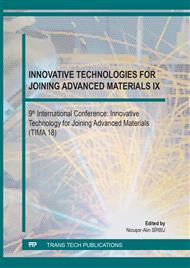p.64
p.78
p.85
p.92
p.98
p.103
p.108
p.113
p.119
Preventive Repetitive Maintenance Applications in the Field of High Wear Subjected Surfaces
Abstract:
The paper presents three applications for maintenance of soil processing tools, achieved by loading through welding of rough layers, of the active surfaces, highly subjected to wear. To achieve this objective we used the preventive repetitive maintenance principles and the concept of fair definition of the wear additional material, in such a way that the rendering activity of active surfaces with the additions will take place in the „dead time” for the manufacturing operation. In concrete situations, of preparing and processing soil, to assure the good functioning of cutting tools in contact with the soil to be processed, in quarries that extract and process basaltic rock aggregates we used a common process of depositing wear protection layers or intelligent self-protection systems, by melting with electric arc of new welding materials that assure in the deposited metal, type Fe-25%Cr-4%W-1%V-Ti-La, hardness of approx. 55HRC and a good welding compatibility with a large palette of low alloyed steels or micro-alloyed with boron, with hardness up to 400 HB. The structure and morphology of the deposits are type austenitic with a high volume of complex carbides of chromium, wolfram and vanadium and reduced, clean inter-crystalline areas, determined by the presence of lanthanides, fact that assures the intelligent protection systems a high tenacity and a good resistance to abrasion wear, specific clay soil with a high content of quartz sand, present in the vest area. The recent change in soil processing systems, by introducing new equipment, determined a rise in wear conditions, especially for scarify and plow coulters teeth and hoeing digger used for growing crops, respectively of useful technologies used in exploitation in conditions of high productivity with low costs.
Info:
Periodical:
Pages:
113-118
Citation:
Online since:
May 2019
Price:
Сopyright:
© 2019 Trans Tech Publications Ltd. All Rights Reserved
Share:
Citation:


